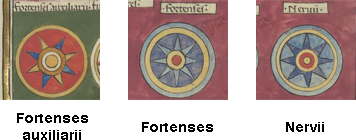
This page created 5 April 2014, and last modified: 9 July 2015 (Name derivation discussion updated)

In the eastern half of the empire, the fourth of the legiones palatina units listed (9.20 in Ingo Maier's numbering scheme) in the the command of the first Master of the Soldiers in the Imperial Presence (i.e. the Magister Militum Praesentalis I) is the Fortenses. Its shield pattern (7#5) as shown in various manuscripts, under the matching label (7.e) Fortenses, is as below:

The pattern features a red boss encircled by a yellow band. A light blue 8-pointed star (yellow in W) radiates therefrom into an indigo main ground (purple in B, faded to maroon in M, W), which is bordered by a yellow band and finally by a light blue band forming the shield's rim. The star points show an internal line in O, M, and B, perhaps suggesting raised embossing. The pattern is thus very similar to that of the next unit (9.21) under the same commander, the Nervii, as can be seen from following patterns taken from the Paris manuscript:

Given the similar shield patterns and the adjacent ranking under the same commander, it is likely that these two units were habitually brigaded together. This conclusion is further fortified when one considers that the names Fortenses and Nervii both mean (amongst other things) "steadfast"; see my commentary under the Nervii.
Various other units of Fortenses are listed in the Notitia:
15.28 Fortenses auxiliarii, a pseudocomitatenses unit under Magister Militum per Orientem;Of these, the three African units may well be one and the same, if not merely detachments of the same unit. None of these other Fortenses units have comparable rank (i.e. none have palatine status). However, the pseudocomitatenses unit under the Magister Militum per Orientem has the very suggestive name of the Fortenses auxiliarii - i.e. "the Fortenses' assistants", which, as can be seen above, also happens to have a shield pattern featuring an 8-pointed star with a similar shape (the shield patterns of the other units, where known, are dissimilar). It may be that this unit was at some point brigaded with the palatine Fortenses unit, hence its name and pattern, but was later posted elsewhere. Given its pseudocomitatenses status, this implies a recent posting to the Magister Militum per Orientem's command from a limitanei command, and not from a palatine army like that of the Magister Militum Praesentalis I. If this is the case, it may well imply the Fortenses and the Nervii had already been established as a paired brigade before the formation of the command of the Magister Militum per Orientem was organised.
102/5.182 Fortenses, a legiones comitatenses unit under the "Comes" Hispenias;
102/5.204 Fortenses, a legiones comitatenses unit under the Comes Africae;
132.2 Numerus Fortensium, a limitanei numerus under the Comes litoris Saxonici per Britanniam;
137.5 Limites Fortenses, a limitanei unit under the Dux et praeses provinciae Mauritaniae et Caesariensis;
139.13 Milites Fortenses, a limitanei unit under the Dux Provinciae Tripolitanae;
143.6 Cuneus equitum Fortensium, a limitanei cavalry cuneus under the Dux Provinciae Valeriae ripensis; and the
143.27 Auxilia Fortensia, a limitanei auxiliary infantry unit under the Dux Provinciae Valeriae ripensis.
The name Fortenses means "brave", or "steadfast", and the reason many other units in the Notitia bear the name is being given the additional name fortis was a common reward under the early empire for a unit that had performed well in battle. The Fortenses thus may well be a detachment or descendent of a old legion bearing the moniker fortis. One such legion was the Legio II Traiana Fortis Germanica, detachments of which are listed under both the Comes limitis Aegypti and the Dux Thebaidos. Another possibility might be the otherwise unattested Legio X Fortenses apparently mentioned by Ammianus in the mid 4th century (see the discussion under the Dux Palaestinae). Of course, it may be that the different legionary Fortenses units acquired their names after being split off from their parent legions, in which case the eastern Fortenses could derive from almost any legion. However, its palatine rank implies it had been part of the regional field armies for a very long time. On balance, I would suggest the eastern palatine Fortenses legion was derived from Legio II Traiana, possibly via a vexillation (detachment) that was involved in the sacking of the Persian capital Ctesiphon in 283. The army involved in the expedition acclaimed Diocletian (hitherto named Diocles) Augustus in late 284 upon the death of the expedition's commander, the Augustus Numerianus, brother of the Augustus Carinus. Diocletian subsequently led his forces west to defeat Carinus in 285 in what is now Serbia. Such a vexillation would have been well-placed to form part of the nucleus of the new imperial reserve that later evolved into the palatine field forces. However, the 3rd century may well have been too early for such a development, at least for the Fortenses (in contrast, the Lanciarii are well-attested for this date). Interestingly, tetradrachms (Emmett 4004 3, Milne 4743) of the emperor Carinus were minted in Alexandria in in the 3rd year of his reign, and thus seemingly after the death of his brother, that bear the image of the eagle of Legio II Traiana, as identified by the legend (in Greek) "LEGO TRAI" or "LEGO B TRAI L G". Perhaps these were an attempt to secure the loyalty of the legion in Egypt, or buy the loyalty of a detachment serving with Diocletian.

Return to the Notitia alphabetical unit list page.
Return to my Notitia index page.